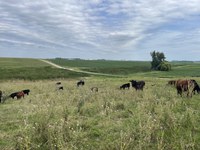NDSU veterinarian advises cattle producers to be on the lookout for anthrax
(Click the image below to view a high-resolution image that can be downloaded)
Anthrax is a concern for cattle producers in North Dakota, as weather conditions in some areas once again have been favorable for this disease. Recently, an anthrax case has been identified in Stark County, North Dakota.
Anthrax is a disease in cattle caused by the bacteria Bacillus anthracis. This bacteria is able to form spores that are highly resistant to heat, cold and disinfection, and can survive in soil for years until conditions are favorable. When these spores come into contact with susceptible cattle, they can “hatch” and cause infection, leading to disease and death.
“Cattle producers should be aware that the threat of anthrax is increased when areas receive high amounts of rainfall as well as prolonged, dry conditions,” says Dr. Jake Galbreath, North Dakota State University Extension veterinarian.
Dry conditions cause the anthrax bacteria to form spores. High rainfall can disturb soil, releasing anthrax spores which can stick to plant material. These spores can be inhaled when soil is disturbed or in grazing areas with previously high water levels.
In most cases, the only sign of anthrax is finding dead cattle, often with blood coming from the nose, mouth and anus. Sudden death in cattle can occur for a number of reasons, including lightning strike, clostridial infection and toxicities. However, anthrax should always be considered in any such case. If anthrax is suspected, it is important that the carcass not be moved or cut into to avoid further contamination of the area. When anthrax bacteria within the carcass are exposed to oxygen, large numbers of spores are produced, which can enter the soil or infect other animals.
A veterinarian should obtain a blood sample and submit it to the NDSU Veterinary Diagnostic Laboratory for testing. Veterinarians should contact the lab when sending in samples from a suspected anthrax case so lab staff can be prepared to receive them.
If anthrax is confirmed, all cattle should be vaccinated immediately. A commercial vaccine is available for cattle, sheep, goats, swine and horses. It is a 1cc dose that is administered subcutaneously (under the skin) in the neck for cattle. A booster vaccination in two to three weeks may be recommended when anthrax is present. The vaccine is then boostered annually.
Treatment with antibiotics at the time of vaccination can interfere with immune response, but in an outbreak situation, antibiotic administration may help prevent further deaths. Cattle producers should contact their local veterinarian to determine the best response for their herd.
“Cattle should be moved from the affected pasture if possible to prevent further infections, as it will take at least a week for protective antibodies to form after vaccination,” says Galbreath.
Anthrax has the potential to infect humans, so take care not to disturb the carcass. The recommended method of disposal is to burn the carcass and the soil on which the carcass was found after placing them in a trench dug in the immediate area of the death.
For more information, visit the NDSU Extension publication “Naturally Occurring Anthrax in the Environment” at ndsu.ag/anthrax25.
NDSU Agriculture Communication – Aug. 14, 2025
Source: Jake Galbreath, 701-991-1855, justin.galbreath@ndsu.edu
Editor: Dominic Erickson, 701-231-5546, dominic.erickson@ndsu.edu


